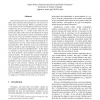Free Online Productivity Tools
i2Speak
i2Symbol
i2OCR
iTex2Img
iWeb2Print
iWeb2Shot
i2Type
iPdf2Split
iPdf2Merge
i2Bopomofo
i2Arabic
i2Style
i2Image
i2PDF
iLatex2Rtf
Sci2ools
DSN
2005
IEEE
2005
IEEE
How Resilient are Distributed f Fault/Intrusion-Tolerant Systems?
Fault-tolerant protocols, asynchronous and synchronous alike, make stationary fault assumptions: only a fraction f of the total n nodes may fail. Whilst a synchronous protocol is expected to have a bounded execution time, an asynchronous one may execute for an arbitrary amount of time, possibly sufficient for f + 1 nodes to fail. This can compromise the safety of the protocol and ultimately the safety of the system. Recent papers propose asynchronous protocols that can tolerate any number of faults over the lifetime of the system, provided that at most f nodes become faulty during a given interval. This is achieved through the socalled proactive recovery, which consists of periodically rejuvenating the system. Proactive recovery in asynchronous systems, though a major breakthrough, has some limitations which had not been identified before. In this paper, we introduce a system model expressive enough to represent these problems which remained in oblivion with the classical models. We...
Asynchronous | Computer Networks | DSN 2005 | Fault/intrusion-tolerant Distributed System | Proactive Recovery |
| Added | 24 Jun 2010 |
| Updated | 24 Jun 2010 |
| Type | Conference |
| Year | 2005 |
| Where | DSN |
| Authors | Paulo Sousa, Nuno Ferreira Neves, Paulo Veríssimo |
Comments (0)

